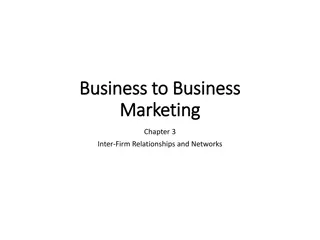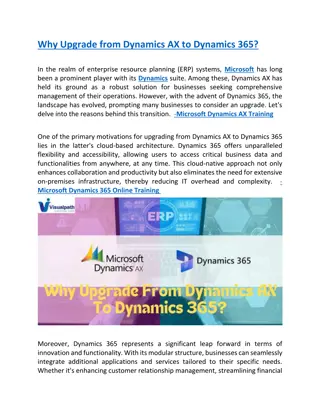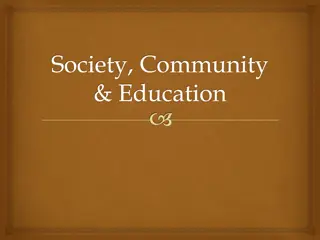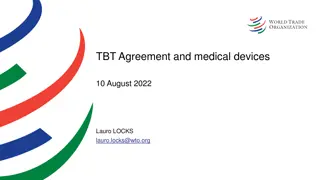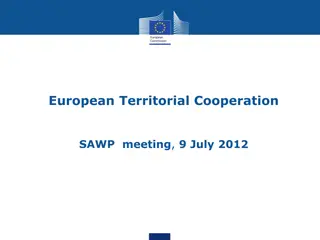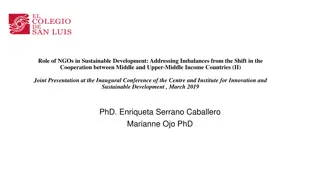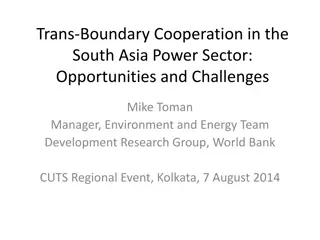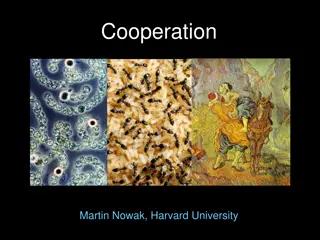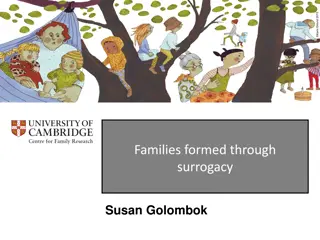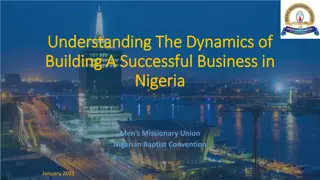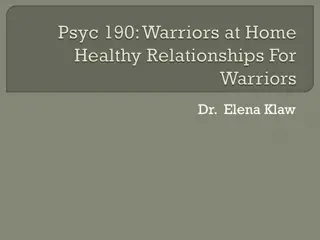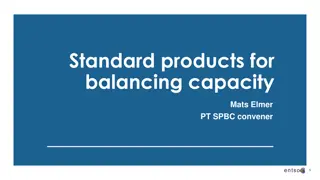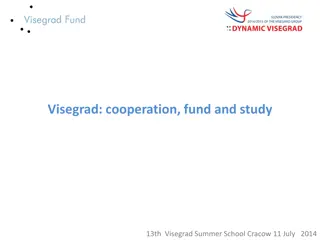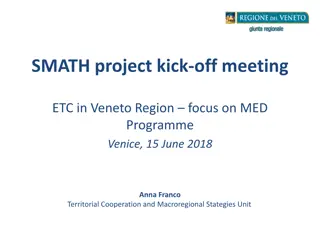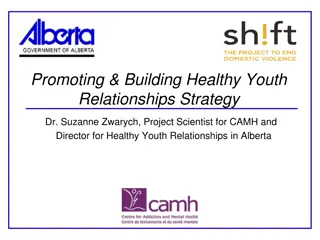Understanding Relationships in Business: Stakeholders, Dynamics, and Cooperation
Exploring the intricate web of relationships in business, this content delves into the dynamics between stakeholders such as workers, managers, entrepreneurs, investors, and customers. It discusses the nuances of cooperative and competitive relationships, dependent relationships, and dynamic interactions among stakeholders, providing insights into how these relationships can shape the success or challenges faced in the business world.
Download Presentation

Please find below an Image/Link to download the presentation.
The content on the website is provided AS IS for your information and personal use only. It may not be sold, licensed, or shared on other websites without obtaining consent from the author. Download presentation by click this link. If you encounter any issues during the download, it is possible that the publisher has removed the file from their server.
E N D
Presentation Transcript
//1 PEOPLE AND RELATIONSHIPS IN BUSINESS
PEOPLE IN BUSINESS Objectives 1.1 Understand the relationship between the principal parties in business and their dynamic nature. 1.3.1 List the main parties and people involved in business. 1.3.2 Describe the relationships between people as workers, managers, entrepreneurs, investors and customers. 1.3.5 Analyse the relationships between people in business. (HL)
UNDERSTANDING RELATIONSHIPS BETWEEN STAKEHOLDERS In this section we will Describe the relationships between people as workers, as trade union members, as managers, as entrepreneurs, as investors and as customers. Describe examples of co-operative and competitive relationships. Outline, using examples, the relationships that can exist between stakeholders in business. Analyse the relationships between people in business. (HL)
UNDERSTANDING RELATIONSHIPS BETWEEN STAKEHOLDERS Key Terms Co-operative relationship, competitive relationship, dependent relationship, dynamic relationship
UNDERSTANDING RELATIONSHIPS BETWEEN STAKEHOLDERS In business, a web of relationships exists between stakeholders. Each stakeholder has their own wants and objectives that they will strive to achieve. 1. When stakeholders work together towards a common goal or objective, they have a co-operative relationship. They act in a way that benefits both parties (is mutually beneficial or win win). 2. When stakeholders are rivals or pursue an objective at the other s expense, they have a competitive relationship (or a win lose relationship).
UNDERSTANDING RELATIONSHIPS BETWEEN STAKEHOLDERS (continued) 3. When stakeholders are reliant on each other to achieve their individual goals, they have a dependent relationship. 4. When the relationship between stakeholders is changeable, it is called a dynamic relationship. At times they may co-operate or depend on each other and at other times they may be in competition.
Co-operative and competitive relationships 1. Entrepreneur and investor Co-operative The entrepreneur shares honest information with the investor (such as an accurate business plan and cash flow forecasts) and in return the investor offers finance for a reasonable share or interest rate. Competitive An investor may want immediate or greater returns from profits, rather than allowing the owner to keep funds for further expansion something an entrepreneur might prefer, but a greater risk for the investor.
Co-operative and competitive relationships 2. Rival businesses Co-operative Rivals in the marketplace could decide to share market research costs. For example, Ryanair and Aer Lingus might share the cost of one market research study on airline customers holiday habits. They both benefit by receiving better information on their shared market than they could afford individually. Competitive An investor may want immediate or greater returns from profits, rather than allowing the owner to keep funds for further expansion something an entrepreneur might prefer, but a greater risk for the investor.
Co-operative and competitive relationships 3. Employer and employee Co-operative An employer may pay for an external training course for the employee. The employer benefits because their employee becomes more skilled, while the employee benefits because they paid nothing to gain a qualification and the new skills may help them towards a promotion. Competitive An employer may treat employees as though they are simply another expense, rather than allies in making the business a success. This can lead to low morale in the workforce.
Co-operative and competitive relationships 4. Producer and consumer Co-operative The producer provides a quality product at a reasonable price, while the consumer pays a reasonable price for the product based on its quality and value for money. The producer has an open complaints procedure and consumer complaints are dealt with in a fair manner. Competitive The business wants to sell the product at the highest price possible to generate profits and satisfy investors. The consumer wants quality products at the lowest price possible, in order to have more disposable income. If the business cannot offer more attractive prices, consumers will shop around and brand loyalty will drop.
Co-operative and competitive relationships 5. Supplier and business Co-operative The supplier provides good-quality raw materials, parts or finished goods on time to the purchasing manager of a business, who pays on time and offers a fair price. This builds a dependable, stable relationship, which benefits both parties Competitive Conflict may arise between the two and have a negative effect on both. For example: if the supplier is unreliable in completing orders or in the quality of goods, the business could go to a rival supplier.
Co-operative and competitive relationships 6. Business and government Co-operative The business provides employment for people in a local community (reducing social welfare payments for the government) and pays taxes. The government uses state bodies such as Enterprise Ireland to offer financial support and advice to businesses and also maintains the necessary infrastructure for their business operations Competitive If the business fails to pay taxes to the government or deliberately underpays what it owes, the government has less money for public services such as health care and infrastructure maintenance.
Dependent relationships Dependent relationships between stakeholders are very common. Examples of a dependent business relationship include: The consumer needs the producer to make the goods they need or want; the producer needs the consumer to buy their products so that they can make a profit. The government needs entrepreneurs to set up businesses and provide employment; entrepreneurs may get a government grant to help them set up or expand their business.
Dependent relationships (continued) Businesses need service providers, e.g. banks, solicitors or insurance providers, to operate successfully and legally; service providers need businesses as customers to be profitable. The entrepreneur needs the investor to give them capital and the investor needs the percentage return on profits.
Dynamic relationships Relationships between stakeholders can easily change. Examples of a dynamic business relationship include: A bank acts as investor for a business by granting a large loan and expects regular and punctual repayments. If the business is failing and cannot make the repayments, the bank may have to take the business premises to recoup (reclaim) its investment. Some businesses sell shares to their employees. In this case, the employee has become an investor in the business as well as part of the workforce. Rival businesses may co-operate temporarily for mutual benefit, for instance by organising an event (e.g. a food festival) together to showcase their products to a wider consumer base.
Think Tank Define the terms co-operative and competitive in the context of business relationships. When stakeholders work together towards a common goal, they have a co-operative relationship. They act in a way that benefits both parties (is mutually beneficial or win win). When stakeholders are rivals or pursue an objective at the other s expense, they have a competitive (or win lose) relationship.
Think Tank Illustrate your understanding of a co-operative relationship between an entrepreneur and an investor. A relationship where stakeholders work together towards a common goal. It is a win win relationship. The investor provides the capital necessary for the entrepreneur to use in developing a new product or service and to make a return on investment. The entrepreneur shares honest information with the investor (such as accurate business plans and cash flow forecasts) and in return the investor offers finance for a reasonable share or interest rate.
Think Tank Explain the meaning of: (a) a dependent relationship and (b) a dynamic relationship. (a) When a stakeholder cannot achieve their own goals without the help of another stakeholder, they have a dependent relationship. (b) When the relationship between stakeholders changes regularly, it is called a dynamic relationship. At times they may co-operate or depend on each other and at other times they may be in competition.
Think Tank Describe a competitive relationship between employers and employees. An employer may treat employees as though they are simply another expense, rather than allies in making the business a success. This can lead to low morale in the workforce. To lower costs, an employer may reduce wages or even reduce the number of employees. Poor industrial relations and conflict become more likely in these situations. Remaining employees may also fear for their own jobs and become less productive.
Think Tank Explain a co-operative relationship between producers and consumers, with one example. The producer provides a quality product at a reasonable price, while the consumer pays a reasonable price for the product based on its quality and value for money. The producer has an open complaints procedure and consumer complaints are dealt with in a fair manner.
Think Tank Give an example of a co-operative relationship between government and business. The business provides employment for people in a local community (reducing social welfare payments for the government) and pays taxes. The government uses state bodies such as Enterprise Ireland to offer financial support and advice to businesses and maintains the necessary infrastructure for their business operations.
Think Tank Outline one example of a dependent relationship between two stakeholders. The consumer needs the producer to make the goods they need or want; the producer needs the consumer to buy their products so that they can make a profit.
Think Tank Outline one example of a dynamic relationship between two stakeholders. A bank acts as investor for a business by granting a large loan and expects regular and punctual repayments. If the business is failing and cannot make the repayments, the bank may have to take the business premises to recoup (reclaim) its investment.




